{ DOWNLOAD AS PDF }
 ABOUT AUHTORS
ABOUT AUHTORS
MNL Aishwarya, E. Anka Rao, M. Niranjan Babu
Department of Pharmaceutics
Seven Hills College of Pharmacy, Tirupati, AP, India
meenumakkhan@gmail.com
ABSTRACT
Esomeprazole is a proton pump inhibitor used to treat gastric problems mainly peptic ulcers. Peptic ulcers are present in around 4% of the population. They newly began in around 53 million people in 2013. About 10% of people develop a peptic ulcer at some point in their life.They resulted in 301,000 deaths in 2013 down from 327,000 deaths in 1990. The first description of a perforated peptic ulcer was in 1670 in Princess Henrietta of England. H. pylori was first identified as causing peptic ulcers by Barry Marshall and Robin Warren in the late 20th century, a discovery for which they received the Nobel Prize in 2005. Esomeprazole comes under non-surgical treatment for peptic ulcers. Though it is an effective drug used for the treatment of peptic ulcers it includes some side effects such as headache, nausea, diarrhea, decreased appetite…etc., optical isomer of omeprazole is called as s-isomer of omeprazole or esomeprazole which is an improved form of omeprazole. Esomeprazole in combination with cardiovascular drugs produces potential interactions and positive effects. This review article provides an evaluation of the literature on the concomitant use of esomeprazole available. The efficacy, safety, tolerability, cost effectiveness, and patient quality of life of this regimen is discussed. A summary of the pharmacokinetic and pharmacodynamic interactions of esomeprazole, Mechanism of action of omeprazole, as well as its effects during pregnancy are also reviewed.
[adsense:336x280:8701650588]
REFERENCE ID: PHARMATUTOR-ART-2457
|
PharmaTutor (ISSN: 2347 - 7881) Volume 5, Issue 1 Received On: 12/08/2016; Accepted On: 13/09/2016; Published On: 01/01/2017 How to cite this article: Aishwarya MNL, Rao EA, Babu MN; A Review on Gastro-Intestinal Drug Esomeprazole; PharmaTutor; 2017; 5(1); 19-26 |
INTRODUCTION
The stomach is an important organ in the body. It plays a vital role in digestion of foods, releases various enzymes and also protects the lower intestine from harmful organisms. The stomach connects to the esophagus above and to the small intestine below. It is intricately related to the pancreas, spleen and liver. The stomach does vary in size but its J shape is constant. The stomach lies in the upper part of the abdomen just below the left rib cage.
Gastropathy is a general term used for stomach diseases. Examples including the name include portal hypertensive gastropathy and Ménétrier's disease, also known as "hyperplastic hypersecretory gastropathy". However, there are many other stomach diseases that don't include the word "gastropathy" such as gastric or peptic ulcer disease, gastroparesis, and dyspepsia.
Many stomach diseases are associated with infection. Historically, it was widely believed that the highly acidic environment of the stomach would keep the stomach immune from infection. However, a large number of studies have indicated that most cases of stomach ulcers, gastritis, and stomach cancer are caused by Helicobacter pylori infection. One of the ways it is able to survive in the stomach involves its urease enzymes which metabolize urea (which is normally secreted into the stomach) to ammonia and carbon dioxide which neutralises gastric acid and thus prevents its digestion. In recent years, it has been discovered that other Helicobacter bacteria are also capable of colonising the stomach and have been associated with gastritis.
Having too little or no gastric acid is known as hypochlorhydria or achlorhydria respectively and are conditions which can have negative health impacts. Having high levels of gastric acid is called hyperchlorhydria. Many people believe that hyperchlorhydria can cause stomach ulcers. However, recent research indicates that the gastric mucosa which secretes gastric acid is acid-resistant.
Gastritis and stomach cancer can be caused by Helicobacter pylori infection.[1]
WHAT IS A STOMACH ULCER?
Stomach ulcers are painful sores that can be found in the stomach lining or small intestine. Stomach ulcers are the most visible sign of peptic ulcer disease. They occur when the thick layer of mucus that protects your stomach from digestive juices is reduced, thus enabling the digestive acids to eat away at the lining tissues of the stomach.
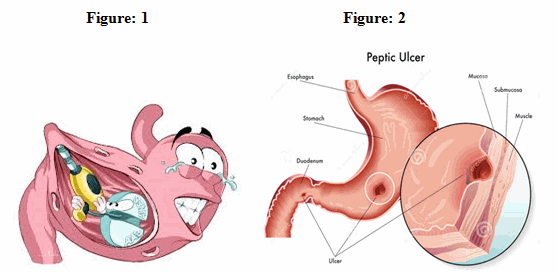
Stomach ulcers are easily cured, but they can become severe without proper treatment.
TREATING STOMACH ULCERS:
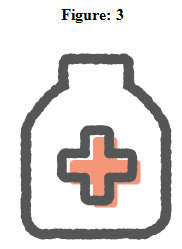 Treatment will vary depending on the cause of your ulcer. Most ulcers can be treated with a prescription from your doctor, but in rare cases, surgery may be required.
Treatment will vary depending on the cause of your ulcer. Most ulcers can be treated with a prescription from your doctor, but in rare cases, surgery may be required.
It’s important to promptly treat an ulcer. Talk to your doctor to discuss a treatment plan. If you have an actively bleeding ulcer, you’ll likely be hospitalized for intensive treatment with IV ulcer medications, and you may also require blood transfusion.
1. NONSURGICAL TREATMENT:
If your stomach ulcer is the result of H. pylori, you’ll need antibiotics. For mild to moderate stomach ulcers, your doctor will usually prescribe the following medications:
a. H2 BLOCKERS: To prevent your stomach from making too much acid
MECHANISM OF ACTION:
H2 antagonists, also called H2 blockers, are a class of medications that block the action of histamine at the histamine H2 receptors of the parietal cells in the stomach. This decreases the production of stomach acid. H2 antagonists can be used in the treatment of dyspepsia, but have been surpassed by the more effective proton pump inhibitors. They are also used to treat peptic ulcer disease and gastroesophageal reflux disease.
ADVERSE EFFECTS:
Infrequent ADRs include hypotension. Rare ADRs include: headache, tiredness, dizziness, confusion, diarrhea, constipation, and rash.
Eg:
| GENERIC NAME | BRAND NAME |
|---|---|
|
cimetidine |
Tagamet |
|
famotidine |
Pepcid |
|
nizatidine |
Axid |
|
ranitidine |
Zantac [2] |
b. PROTON PUMP INHIBITORS: Blocks the cells that produce acid
MECHANISM OF ACTION:
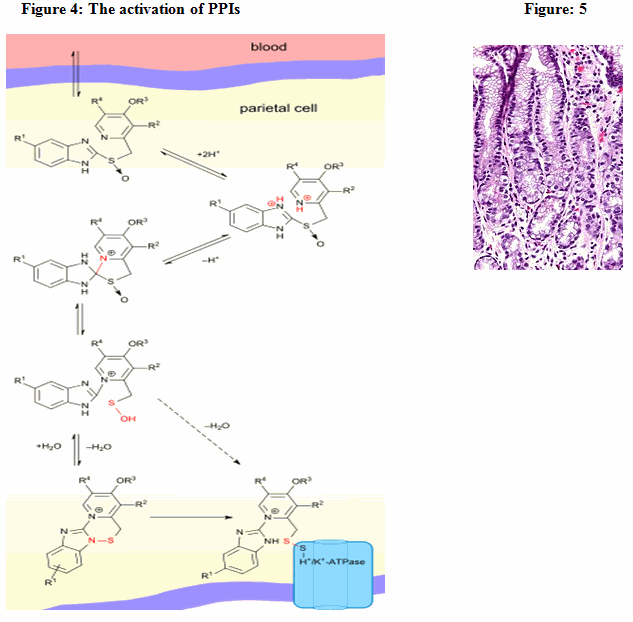
ADVERSE EFFECTS:
Common adverse effects include headache, nausea, diarrhea, abdominal pain, fatigue, and dizziness. Infrequent adverse effects include rash, itch, flatulence, constipation, anxiety, and depression. Also infrequently, PPI use may be associated with occurrence of myopathies, including the serious reaction rhabdomyolysis.[3]
Eg:
- Omeprazole (OTC; brand names: Gasec, Losec, Prilosec, Zegerid, ocid, Lomac, Omepral, Zolppi, Omez, Omepep, UlcerGard, GastroGard, Altosec)
- Lansoprazole (brand names: Prevacid, Zoton, Monolitum, Inhibitol, Levant, Lupizole)
- Dexlansoprazole (brand name: Kapidex, Dexilant)
- Esomeprazole (brand names: Nexium, Esotrex, esso)
2. SURGICAL TREATMENT:
In very rare cases, a complicated stomach ulcer will require surgery. These include ulcers that:
- continue to return
- don’t heal
- bleed
- tear the stomach or small intestine
- keep food from flowing out of the stomach into the small intestine
Surgery may include:
- removal of the entire ulcer
- taking tissue from another part of the intestines and sewing it over the ulcer site
- tying off a bleeding artery
- cutting off nerve supply to the stomach to reduce the production of stomach acid[4].
NOW YOU CAN ALSO PUBLISH YOUR ARTICLE ONLINE.
SUBMIT YOUR ARTICLE/PROJECT AT editor-in-chief@pharmatutor.org
Subscribe to Pharmatutor Alerts by Email
FIND OUT MORE ARTICLES AT OUR DATABASE
ESOMEPRAZOLE:
Esomeprazole sold under the brand name Nexium among others, is a proton pump inhibitor which reduces stomach acid. It is used in the treatment of dyspepsia, peptic ulcer disease, gastroesophageal reflux disease, and Zollinger-Ellison syndrome.
It decreases secretion of acid through inhibition of the H+/K+-ATPase in the parietal cells of the stomach. By inhibiting the functioning of this transporter, the drug prevents formation of stomach acid.
Esomeprazole is the (S)-(−)-enantiomer of omeprazole. Esomeprazole is currently sold over the counter in the US and the UK.
STRUCTURE:

|
Systematic (IUPAC) name |
|||
|
(S)-(−)-5-Methoxy-2-[(4-methoxy-3,5-dimethylpyridin-2-yl)methylsulfinyl]-3H-benzoimidazole |
|||
|
Pharmacokinetic data |
|||
|
Bioavailability |
50 to 90% |
||
|
Metabolism |
Hepatic (CYP2C19, CYP3A4) |
||
|
Biological half-life |
1–1.5 hours |
||
|
Excretion |
80% Renal |
||
PHARMACOKINETICS:
Single 20– to 40-mg oral doses generally give rise to peak plasma esomeprazole concentrations of 0.5-1.0 mg/l within 1–4 hours, but after several days of once-daily administration, these levels may increase by about 50%. A 30-minute intravenous infusion of a similar dose usually produces peak plasma levels on the order of 1–3 mg/l. The drug is rapidly cleared from the body, largely by urinary excretion of pharmacologically inactive metabolites such as 5-hydroxymethylesomeprazole and 5-carboxyesomeprazole. Esomeprazole and its metabolites are analytically indistinguishable from omeprazole and the corresponding omeprazole metabolites unless chiral techniques are employed.[5]
DOSAGE FORMS:
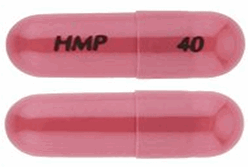
Figure 6: Some 40-mg Nexium brand esomeprazole magnesium capsules
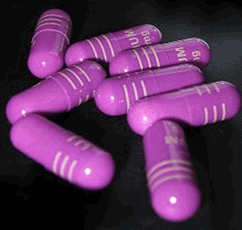
Figure 7: Esomeprazole strontium delayed-release capsules, 49.3 mg
MECHANISM OF ACTION OF OMEPRAZOLE:
The success of omeprazole in the clinic can be ascribed to the very effective inhibition of gastric acid secretion achieved through specific inhibition of the gastric H+K+-ATPase. This proton pump is located in the secretory membranes of the parietal cell of the gastric mucosa and constitutes the final step of acid secretion (FIG. 4a). Therefore, blockade of this pump results in a more specific inhibition of acid secretion compared with blockade of the more widely distributed H2 and cholinergic receptors Furthermore, as omeprazole interacts with the final step of acid production, the inhibition of gastric acid secretion is independent of how acid secretion is stimulated — an important advantage over other pharmacological approaches to inhibiting acid secretion. For example, the inhibition of acid secretion by H2-receptor antagonists can be overcome by foodinduced stimulation of acid secretion via gastrin or cholinergic receptors.
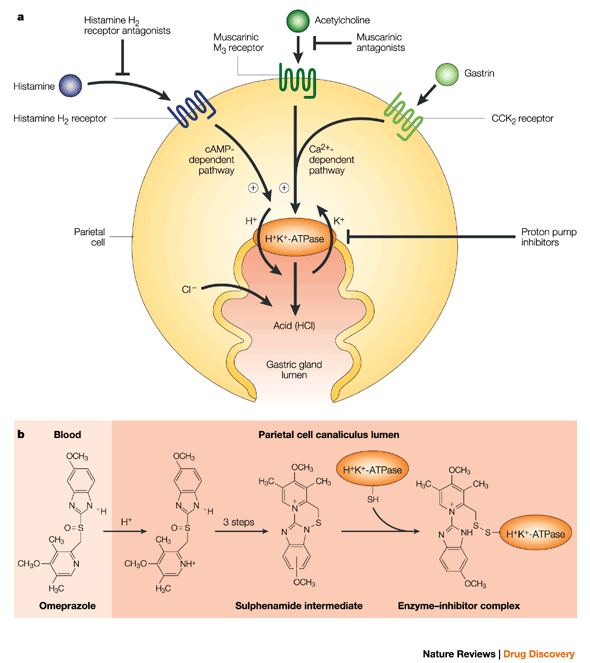
Figure 8:| Proton-pump inhibition. a | Gastric acid is secreted by parietal cells of the stomach in response to stimuli such as the presence of food in the stomach or intestine and the taste, smell, sight or thought of food. Such stimuli result in the activation of histamine, acetylcholine or gastrin receptors (the H2, M3 and CCK2 receptors, respectively) located in the basolateral membrane of the parietal cell, which initiates signal transduction pathways that converge on the activation of the H+K+-ATPase — the final step of acid secretion. Inhibition of this proton pump has the advantage that it will reduce acid secretion independently of how secretion is stimulated, in contrast to other pharmacological approaches to the regulation of acid secretion; for example, the inhibition of acid secretion by H2 receptor antagonists can be overcome by food-induced stimulation of acid secretion via gastrin or acetylcholine receptors.
b | Proton-pump inhibitors such as omeprazole are prodrugs that are converted to their active form in acidic environments. Omeprazole is a weak base, and so specifically concentrates in the acidic secretory canaliculi of the parietal cell, where it is activated by a proton-catalysed process to generate a sulphenamide. The sulphenamide interacts covalently with the sulphydryl groups of cysteine residues in the extracellular domain of the H+K+-ATPase — in particular Cys 813 — thereby inhibiting its activity. The specific concentration of proton-pump inhibitors such as omeprazole in the secretory canaliculi of the parietal cell is reflected in their favourable side-effect profile.
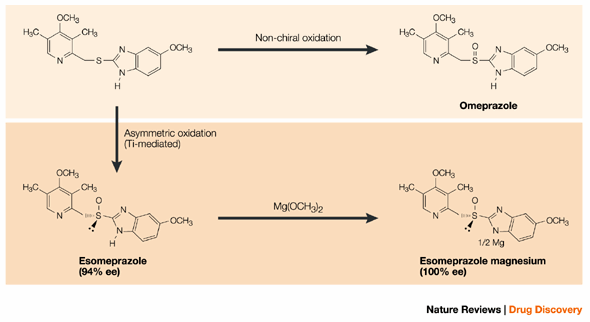
Figure 9: | Synthesis of omeprazole and esomeprazole. The large-scale production of esomeprazole is achieved by asymmetric oxidation of the same sulphide intermediate as is used in the production of omeprazole, which gives a 94% enantiomeric excess (ee). This is increased to 100% by preparing a magnesium salt of of esomeprazole and then performing a crystallization.[6]
NOW YOU CAN ALSO PUBLISH YOUR ARTICLE ONLINE.
SUBMIT YOUR ARTICLE/PROJECT AT editor-in-chief@pharmatutor.org
Subscribe to Pharmatutor Alerts by Email
FIND OUT MORE ARTICLES AT OUR DATABASE
INTERACTIONS:
Esomeprazole is a competitive inhibitor of the enzyme CYP2C19, and may therefore interact with drugs that depend on it for metabolism, such as diazepam and warfarin; the concentrations of these drugs may increase if they are used concomitantly with esomeprazole. Conversely, clopidogrel (Plavix) is an inactive prodrug that partially depends on CYP2C19 for conversion to its active form; inhibition of CYP2C19 blocks the activation of clopidogrel, thus reducing its effects.
Drugs that depend on stomach pH for absorption may interact with omeprazole; drugs that depend on an acidic environment (such as ketoconazole or atazanavir) will be poorly absorbed, whereas drugs that are broken down in acidic environments (such as erythromycin) will be absorbed to a greater extent than normal.[7]
ADVERSE EFFECTS:
Common side effects include headache, diarrhoea, nausea, flatulence, decreased appetite, constipation, dry mouth, and abdominal pain. More severe side effects are severe allergic reactions, chest pain, dark urine, fast heartbeat, fever, paresthesia, persistent sore throat, severe stomach pain, unusual bruising or bleeding, unusual tiredness, and yellowing of the eyes or skin.
Proton pump inhibitors may be associated with a greater risk of hip fractures and Clostridium difficile-associated diarrhoea. Patients are frequently administered the drugs in intensive care as a protective measure against ulcers, but this use is also associated with a 30% increase in occurrence of pneumonia.[8]
MEDICAL USE:
The primary uses of esomeprazole are gastroesophageal reflux disease, treatment and maintenance of erosive esophagitis, treatment of duodenal ulcers caused by H. pylori, prevention of gastric ulcers in those on chronic NSAID therapy, and treatment of gastrointestinal ulcers associated with Crohn's disease.[9][10]
ANTI-ULCER DRUGS PRESCRIBED DURIG PREGNANCY:
Proton pump inhibitors (PPIs) remain central to management of acid-suppression disorders and are considered safe in the general population. About two thirds of pregnant patients develop heartburn. The origin is multifactorial, but the predominant factor is a decrease in lower esophageal sphincter pressure caused by female sex hormones, especially progesterone.
Although serious reflux complications during pregnancy are rare, symptomatic gastroesophageal reflux disorders should be managed during pregnancy. Treatment is based on a step-up algorithm (which moves in a single direction whereas a standard algorithm might have several directions) beginning with lifestyle modifications and dietary changes followed by antacids or sucralfate as first-line medication. Treatment might eventually include PPIs. Information about their safety during pregnancy mostly relates to omeprazole, the oldest PPI in this group. There is, however, some new information on pantoprazole and lansoprazole in pregnant women that should be noted also.
ALGORITHM FOR THE TREATMENT OF PEPTIC ULCER DISEASE:
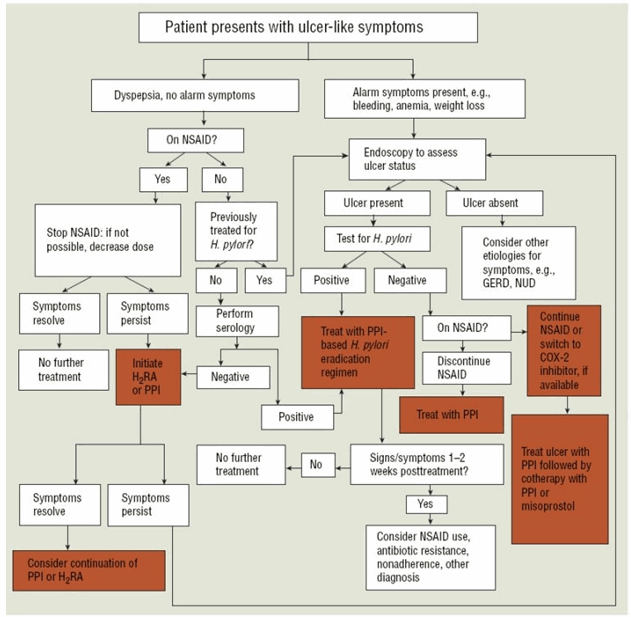
Figure 10: Algorithm guidelines for the evaluation and management of a patient with dyspeptic or ulcer-like symptoms. (COX-2, Cyclooxygenase-2; GERD, gastroesophageal reflux disease; H.Pylori, Helicobacter pylori; H2RA, H2-Receptor Antagonist; PPI, Proton Pump Inhibitor; NSAID, non-steroidal anti-inflammatory drug; NUD, non-ulcer dyspepsia.[11]
CONCLUSION
In general gastric problems such as acidity or gastritis involves increased secretion of acids such as HCl in the mucus memdrane of the stomach. This condition can be resolved or treated by general antacids. But usage of antacids is a temporary treatment but not a permanent solution for gastritis. Thus, the prolonged usage of antacids shows no result on acidity and may leads to chronic conditions of prolonged exposure of stomach walls towards conc.acids , ultimately resulting in severe condition of “PEPTIC ULCER”. However , now a days advancements in drug designs has approached a peer position a resulted in invention of drug “ESOMEPRAZOL”, which comes under non-surgical treatment for chronic disesase peptic ulcers.Though the advancements in pharmaceutical sciences are too fast…. it would be better to follow the proverb “PREVENTION IS BETTER THAN CURE”. This can be achieved by practicing a hale & healthy food habbits and thus one can lead an ulcer free life by gaining awareness about nutitional and vitamin rich foods and by avoiding too spicy and junk foods.
REFERENCES
1. Chronic Stomach Information Retrieved on 2010-01-20
2. Kahrilas, PJ. Gastroesophageal reflux disease. New England Journal of Medicine; 2008; 359(16): 1700-1707.
3. Clark, DW; Strandell J; Myopathy including polymyositis: a likely class adverse effect of proton pump inhibitors?; European Journal of Clinical Pharmacology; 2006; 62(6); 473–479
4. Health line-Stomach ulcer written by Shannon Johnson Medically Reviewed by Steven Kim, MD on August 25, 2015
5. R. Baselt, Disposition of Toxic Drugs and Chemicals in Man, 8th edition, Biomedical Publications, Foster City, CA, 2008, pp. 388-389.
6. A PROTON-PUMP INHIBITOR EXPEDITION: THE CASE HISTORIES OF OMEPRAZOLE AND ESOMEPRAZOLE - Lars Olbe, Enar Carlsson and Per Lindberg-AstraZeneca R&D,431 83 Mölndal, Sweden. Correspondence to L.O. e-mail: lars.olbe@astrazeneca.com
7. Stedman CA, Barclay ML; Review article: comparison of the pharmacokinetics, acid suppression and efficacy of proton pump inhibitors; Aliment. Pharmacol. Ther. ; 2000; 14(8); 963–78.
8. Herzig SJ, Howell MD, Ngo LH, Marcantonio ER ."Acid-suppressive medication use and the risk for hospital-acquired pneumonia". JAMA. 2009; 301 (20); 2120–2128
9. Esomeprazole Magnesium; The American Society of Health-System Pharmacists. Retrieved 3 April 2011.
10. Li J, Zhao J, Hamer-Maansson JE, Andersson T, Fulmer R, Illueca M, Lundborg P; Pharmacokinetic properties of esomeprazole in adolescent patients aged 12 to 17 years with symptoms of gastroesophageal reflux disease: A randomized, open-label study; Clin Ther.; 2006; 28(3); 419–27.
11.Umaee FarmMed , Posted by Umaee Azanuddin at 8:37 PM, Algorithm For Treatment of Peptic Ulcer Disease , Source: Pharmacotherapy 7th
NOW YOU CAN ALSO PUBLISH YOUR ARTICLE ONLINE.
SUBMIT YOUR ARTICLE/PROJECT AT editor-in-chief@pharmatutor.org
Subscribe to Pharmatutor Alerts by Email
FIND OUT MORE ARTICLES AT OUR DATABASE










